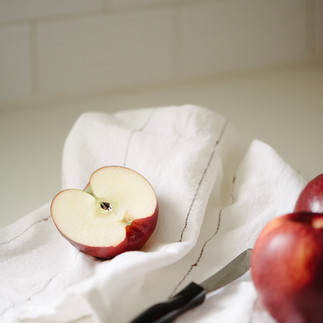The Moonshot Apple Story: Inside the Rise of Cosmic Crisp
- janna225
- Oct 23
- 4 min read
Article by Stasia Brewczynki | Photos by Christina Block | Published October 23, 2025

What would you say is the most important feature in a fresh apple? The shine of its skin? The snap when you bite in? Or the flavor that lingers?
“While consumers often say flavor is the most important factor in choosing an apple, texture is usually the first thing they notice when they take a bite,” said Marlisa Garcia, marketing manager at Proprietary Variety Management, a Yakima, Washington-based leader in the development of proprietary tree fruit varieties. If an apple isn’t crunchy, she explains, customers are simply less likely to buy it again; no amount of sweetness will save it.
A Quest for the Perfect Crunch
This is why horticulturist and now-retired fruit breeder Dr. Bruce Barritt at Washington State University and his team, including fruit breeder and horticulture professor Dr. Kate Evans, set out on a bold experiment: to breed an apple that gave people the crisp bite they crave.
Dr. Barritt grew up in Kelowna, British Columbia, where he developed his green thumb working in the garden alongside his father and grandfather. Then, inspired by a fruit production college internship in the Okanagan Valley, he earned his Ph.D. in pomology from Cornell University in 1969. From there, Dr. Barritt conducted fruit research at Washington State University before focusing his scope on accessing and supporting the inert apple industry in 1985.

A Star is Born: Cosmic Crisp
At the time, the apple market was stagnant. Dr. Barritt found that in Washington State, which produced the majority of the nation’s apple crop then as it does now, and across the country, most farms focused primarily on growing Red Delicious, and to a lesser extent Golden Delicious. First released to the public in 1874, Red Delicious is an apple variety touted for its dazzling waxy red appearance, even after being picked, shipped, and stored on produce shelves. Customers, however, regularly complained about the fruit’s soft, even mealy, texture, and had the same complaint about Golden Delicious. But with so little competition in the marketplace, these apples remained popular. Dr. Barritt believed that if apples were going to win hearts again, the industry needed to listen to the customers. After years of lobbying, Dr. Barritt finally convinced the Washington Tree Fruit Research Commission to let him develop a new breed — this time with a specifically consumer-first approach.
In 1997, Dr. Barritt began combining several dozen apple varieties by traditional cross-pollination, which he described as doing “what the honeybees do,” followed by planting 6,000 to 8,000 of the resulting seeds each year, all to see if one of these parent pairs’ offspring would result in the fruit of the future — an apple that was firm and crisp as well as juicy-sweet while balanced by tart flavor. One such parent pair was the Honeycrisp — beloved for its crisp texture and juicy sweetness, but quick to bruise and labor-intensive to pick. Another was the Enterprise, an apple with a beautiful deep red color, disease resistance, and a long storage life, but often considered a little acidic for eating out of hand.
Crossing the upsides of these two apples — Honeycrisp’s flavor and texture with Enterprise’s looks, disease resistance, and storage life — without the characteristics that were holding each apple back in customers’ estimation was no simple feat. Since each and every apple seed produces a tree entirely unique from its siblings, finding one exceptional seed can feel like a game of chance as much as years of skillful labor, and is certainly the ultimate test of patience. “After rigorous testing and 20-plus years” evaluating flavor, texture, appearance, and storage quality, Garcia said, “one seedling stood out as exceptional, and that’s the apple we now know as Cosmic Crisp.”
From Orchard Dream to Grocery Aisle Hit

Years of hard work and keen observation are evident in the resulting apple: Cosmic Crisp lives up to its name. It keeps exceptionally well, so it can stand up to the practical realities and rigors of harvest, storage, and shipping. The apple’s ample size and vibrant red color, speckled with lighter points like a galaxy full of stars, draw the eye, which in turn helps convert new buyers. Meanwhile, the signature texture is almost embarrassingly crunchy — the result is certainly not something you could ever eat in secret. The flavor captures a crowd-pleasingly juicy sweetness with notes of pear, tropical fruit, and subtle floral character. The fruit’s naturally high level of sugar is balanced by bright acidity for a sweet-tart eating experience that can be enjoyed fresh or in sweet and savory recipes — Cosmic Crisp’s official site recommends trying the apple baked into a caramel ricotta cake, blended into an appletini cocktail, or atop a smoky bacon pizza drizzled with hot honey. Notably, both the color and texture remain when the apple has been baked. And with its slow-to-brown slices, Cosmic Crisp shines on a cheese board as much as in a lunchbox.
Shoppers have noticed. These strengths have translated into major market gains, with Cosmic Crisp seeing the largest recent sales growth among the top 40 apple varieties across the U.S., according to Nielsen sales data. Likewise, the apple became a top-10 variety within its first three years of sales, and plantings are currently projected to reach over 16 million by 2028. Dr. Barritt’s gamble paid off. What started as a moonshot became an apple that redefined the category. Or, as he calls it, simply: “phenomenal.”















